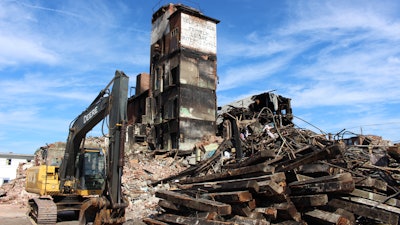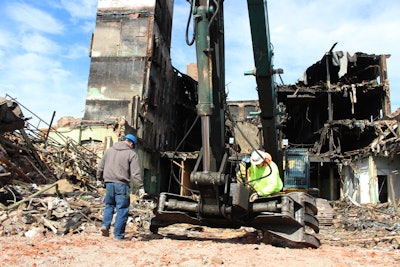
Information from this article was first published in Demolition Magazine and is being reused with permission from the National Demolition Association.
By Alexa Schlosser
On Oct. 7, 2018, a vacant warehouse in Allentown, PA, caught fire. The four-story brick-and-timber building located on the corner of Franklin and Gordon streets was a former manufacturing facility constructed in the early 1960s. By the next day, the building was completely consumed by a multi-alarm blaze that caused some collapse of the structure. The city of Allentown ordered the emergency demolition of the warehouse to prevent the potential danger of further collapse.
“The damage was extensive enough that it created concern for local homeowners, business owners, pedestrians and motorists that frequent the local area,” says Allen Dejewski, vice president of Empire Services. “Once instability was determined, the city of Allentown contacted several local contractors to provide proposals for the demolition of the fire-damaged property.”
National Demolition Association (NDA) member Empire Services was one of those contractors — and the ultimate winner of the bid. “Empire Services was selected during this process for what we believe was competitive pricing, specialty equipment and, most importantly, experience in similar situations,” Dejewski says.
Empire Services mobilized on Oct. 11 and completed the demolition by Nov. 2. According to Dejewski, this quick completion time was assisted by crews working long days and weekends.
 For the job, Empire Services used: a John Deere 160 excavator, a John Deere 450 long reach excavator, a Hitachi 350 long reach excavator, a100-ton Grove hydraulic crane and aGenie 85-foot personnel lift.National Demolition Association
For the job, Empire Services used: a John Deere 160 excavator, a John Deere 450 long reach excavator, a Hitachi 350 long reach excavator, a100-ton Grove hydraulic crane and aGenie 85-foot personnel lift.National Demolition Association
The city closed a couple of adjacent streets, Empire Services placed steel barricades along areas of concern preventing misplacement of materials, and the site was completely encompassed with temporary security fencing.
Once safety measures were in place, demolition of one-story portions of the building started, and the 120-foot-tall deteriorated brick chimney was selectively removed to a safe level. This occurred while the larger equipment was being mobilized to the site and assembled for use. All of the debris was stored in the building basement, enabling equipment to track across the site at ground level. After completing the smaller tasks, it was time to start with the larger equipment.
“Initially, we used conventional John Deere 160 excavators, with later support from a John Deere 450 95-foot long reach excavator and a Hitachi 350 75-foot long reach excavator. Portions of the compromised building were removed manually with assistance of a 100-ton Grove hydraulic crane and Genie 85-foot personnel lift,” Dejewski says.
The demolition strategy was “simple but complex in its own way,” Dejewski says. “Demolish a fire-damaged building with an adjacent building 25 feet away to the north, pole-mounted fiber optics and teledata 10 feet to the east, and buried aging service lines in nearby roadways. This meant work basically needed to be accomplished within the property and building footprint.”
Although the project had multiple challenges to contend with, they were not insurmountable with proper planning, protection and process established in the pre-project meetings. Once the building was demolished, all debris was removed from the basement and stockpiled on-site with the site ready for finalization at a later date.
Overall, Dejewski says the project was a success.
“Success in the industry today is too often measured financially,” he says. “But this unique project was measured in multiple ways. Demolition was completed with no damages to local surroundings; the city was able to re-open sidewalks and roadways within a timely manner; utilities were all operational throughout the project; and Empire’s project team provided a safely demolished structure within a short time period.”


















